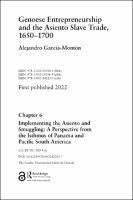Chapter 6 Implementing the Asiento and Smuggling
Proposal review
A Perspective from the Isthmus of Panama and Pacific South America
Abstract
Chapter 6: This chapter adopts an intra-imperial, Spanish American perspective to understand how Domenico Grillo’s factors operated this new monopolistic asiento trade on the ground. It focuses on the Isthmus of Panama and Pacific South America, the most coveted trading areas for the company and where most African captives were brought. The chapter examines the unprecedented privileges wielded by the company’s factors, which triggered the fierce opposition of local players, including other slave traders, tax-farmers, and political leaders. It shows that Grillo’s factors expanded the company’s reach by challenging the privileges of the Sevillian and Lima consulados, smuggling and venturing into trading areas that exceeded the limits of the asiento charter, like Peru. Yet, these pages show in detail that Grillo’s factors could only enter these trading spheres with the cooperation of other Spanish American merchants, middlemen, and political authorities who rapidly started to benefit from the asiento trade. These processes heralded future dynamics of competition and collaboration between other asiento companies and local players. The collective and disputed construction of the asiento trade on the ground bolstered a solid commercial and relational space linking the Spanish Indies to other empires in the Atlantic world and global trade circuits.
Keywords
1650-1700, Asiento, Entrepreneurship, Genoese, Slave, TradeDOI
10.4324/9781003242215-7ISBN
9781032150345, 9781032150369, 9781003242215Publisher
Taylor & FrancisPublisher website
https://taylorandfrancis.com/Publication date and place
2022Imprint
RoutledgeClassification
History of the Americas


 Download
Download